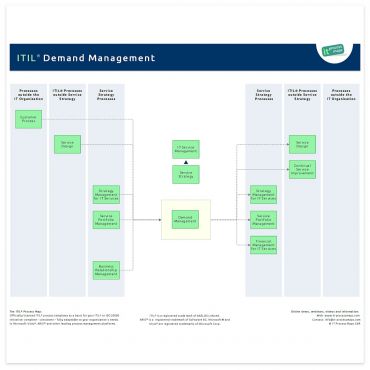ITIL Demand Management: Difference between revisions
Created page with "<seo metakeywords="demand management, itil demand management, demand management itil" metadescription="Demand Management: ITIL process definition - Sub-processes - Terms - Additi..." |
|||
| Line 21: | Line 21: | ||
== Process Description == | == Process Description == | ||
The chapter on Demand Management in the Service Strategy book (ITIL V3 2007 Edition) did not offer enough substance to justify a separate Demand Management process, so at IT Process Maps we decided to treat Demand Management as part of Capacity Management. | |||
[[Image:Demand-management-itil.jpg|right|thumb|370px|alt=Demand Management ITIL|[https://wiki.en.it-processmaps.com/images/pdf/process-overview-demand-management-itil.pdf ITIL Demand Management]]] | [[Image:Demand-management-itil.jpg|right|thumb|370px|alt=Demand Management ITIL|[https://wiki.en.it-processmaps.com/images/pdf/process-overview-demand-management-itil.pdf ITIL Demand Management]]] | ||
Since the latest '''''ITIL 2011''''' guidance includes clarifications on the differences in scope between Demand Management and Capacity Management, a dedicated Demand Management process has been introduced as part of Service Strategy. The process overview of [[Media:Demand-management-itil.jpg|ITIL Demand Management (.JPG)]] is showing the most important interfaces (''see Figure 1''). | Since the latest '''''ITIL 2011''''' guidance includes clarifications on the differences in scope between Demand Management and Capacity Management, a dedicated Demand Management process has been introduced as part of Service Strategy. The process overview of [[Media:Demand-management-itil.jpg|ITIL Demand Management (.JPG)]] is showing the most important interfaces (''see Figure 1''). | ||
| Line 43: | Line 43: | ||
;<span id="Pattern of Business Activity PBA">Pattern of Business Activity (PBA)</span> | ;<span id="Pattern of Business Activity PBA">Pattern of Business Activity (PBA)</span> | ||
:Patterns of Business Activity (PBA) are workload profiles describing the demand for particular services. PBAs are an important tool used by Demand Management for anticipating and influencing service demand. | :Patterns of Business Activity (PBA) are workload profiles describing the demand for particular services. PBAs are an important tool used by Demand Management for anticipating and influencing service demand. ''(Note: New output in ITIL 2011.)'' | ||
<p> </p> | <p> </p> | ||
| Line 75: | Line 75: | ||
<p> </p> | <p> </p> | ||
<html><a rel="author" href="https://profiles.google.com/111925560448291102517"><img style="margin:0px 0px 0px 0px;" src="/skins/Vector/images/itpm/bookmarking/gplus.png" width="16" height="16" title="By: Stefan Kempter | Profile on Google+" alt="Author: Stefan Kempter, IT Process Maps GbR" /></a></html> | |||
<!-- This page is assigned to the following categories: --> | <!-- This page is assigned to the following categories: --> | ||
[[Category:ITIL V3]][[Category:ITIL 2011]][[Category:ITIL process]][[Category:Service | [[Category:ITIL V3]][[Category:ITIL 2011]][[Category:ITIL process]][[Category:Service Strategy|Demand Management]][[Category:ITIL Demand Management|!]] | ||
<!-- --- --> | <!-- --- --> | ||
Revision as of 18:33, 17 February 2013
<seo metakeywords="demand management, itil demand management, demand management itil" metadescription="Demand Management: ITIL process definition - Sub-processes - Terms - Additional information on ITIL Demand Management." />

Overview
Objective: ITIL Demand Management aims to understand, anticipate and influence customer demand for services. Demand Management works with Capacity Management to ensure that the service provider has sufficient capacity to meet the required demand.
Part of: Service Strategy
Process Owner: Demand Manager
Process Description
The chapter on Demand Management in the Service Strategy book (ITIL V3 2007 Edition) did not offer enough substance to justify a separate Demand Management process, so at IT Process Maps we decided to treat Demand Management as part of Capacity Management.

Since the latest ITIL 2011 guidance includes clarifications on the differences in scope between Demand Management and Capacity Management, a dedicated Demand Management process has been introduced as part of Service Strategy. The process overview of ITIL Demand Management (.JPG) is showing the most important interfaces (see Figure 1).
The role Demand Manager has been introduced to perform the activities in the Demand Management process.
Sub-Processes
No sub-processes are specified for ITIL Demand Management.
Definitions
The following ITIL terms and acronyms (information objects) are used in ITIL Demand Management to represent process outputs and inputs:
- Pattern of Business Activity (PBA)
- Patterns of Business Activity (PBA) are workload profiles describing the demand for particular services. PBAs are an important tool used by Demand Management for anticipating and influencing service demand. (Note: New output in ITIL 2011.)
Roles | Responsibilities
- Demand Manager - Process Owner
- The Demand Manager is responsible for understanding, anticipating and influencing customer demand for services. The Demand Manager works with capacity management to ensure that the service provider has sufficient capacity to meet the required demand.
| Responsibility Matrix: ITIL Demand Management | |
| ITIL Role / Sub-Process | Demand Manager |
|---|---|
| Demand Management (no sub-processes specified) |
A[1]R[2] |
Remarks
[1] A: Accountable according to the RACI Model: Those who are ultimately accountable for the correct and thorough completion of the ITIL Demand Management process.
[2] R: Responsible according to the RACI Model: Those who do the work to achieve a task within Demand Management.






